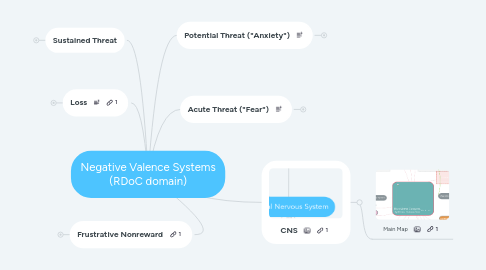
1. Acute Threat ("Fear")
1.1. Molecules
1.1.1. BDNF
1.1.2. CCK
1.1.3. Cortisol
1.1.4. CRF
1.1.5. Dopamine
1.1.6. Endogenous Cannabinoids
1.1.7. FGF2
1.1.8. GABA
1.1.9. Glutamate
1.1.10. Neuropeptide S
1.1.11. Neurosteroids
1.1.12. NMDAR
1.1.13. NPY
1.1.14. Orexin
1.1.15. Oxytocin
1.1.16. Serotonin
1.1.17. Vasopressin
1.2. Genes
1.3. Cells
1.3.1. GABAergic Cells
1.3.2. Glia
1.3.3. Neurons
1.3.4. Pyramidal Cells
1.4. Circuits
1.4.1. ANS
1.4.2. BasAmyg
1.4.3. Central Nucleus
1.4.4. d-hippocampus
1.4.5. v-hippocampus (ant)
1.4.6. dmPFC
1.4.7. vmPFC
1.4.8. dACC
1.4.9. rostral/ventr ACC
1.4.10. Hypothalamus
1.4.11. ICMs
1.4.12. Insular Cortex
1.4.13. LatAmyg
1.4.14. latPFC/insula
1.4.15. LC
1.4.16. Medial Amyg
1.4.17. OFC
1.4.18. PAG
1.4.19. dPAG
1.4.20. vPAG
1.4.21. Pons
1.4.22. RPVM
1.5. Physiology
1.6. Behaviors
1.6.1. Analgesia
1.6.2. Approach
1.6.3. Avoidance
1.6.4. Facial Expressions
1.6.5. Freezing
1.6.6. Open Field
1.6.7. Response Inhibition
1.6.8. Response Time
1.6.9. Risk Assessment
1.6.10. Social Approach
2. Potential Threat ("Anxiety")
2.1. Genes
2.2. Molecules
2.2.1. Cortisol
2.2.2. CRF Family
2.3. Cells
2.3.1. Pituitary Cells
2.4. Circuits
2.4.1. Bed nucleus of stria terminalis
2.5. Physiology
2.5.1. ACTH
2.5.2. Average cortisol Levels
2.5.3. Potentiated Startle
2.6. Behaviors
3. Sustained Threat
3.1. Genes
3.2. Molecules
3.2.1. ACTH
3.2.2. CRF
3.2.3. HPA-axis hormones
3.3. Cells
3.3.1. Hippocampal
3.3.2. Microglia
3.3.3. prefrontal
3.4. Circuits
3.4.1. Attention Network
3.4.2. Dysregulation of amygdala reactivity
3.4.3. Dysregulation of cingulate reactivity
3.4.4. Habit systems (Striatum, caudate, accumbens)
3.4.5. Hypothalamic Nuclei
3.4.6. PVT
3.4.7. Vigilance Network
3.5. Physiology
3.6. Behaviors
4. Loss
4.1. Genes
4.2. Molecules
4.2.1. Androgens
4.2.2. CRH
4.2.3. Estrogens
4.2.4. Glucocorticoid receptors
4.2.5. Inflammatory molecules
4.2.6. Oxytocin
4.2.7. Vasopressin
4.3. Cells
4.4. Circuits
4.4.1. Amygdala
4.4.2. Default Mode Network
4.4.3. dlPFC
4.4.4. vmPFC
4.4.5. Habit Systems (Striatum/caudate/accumbens)
4.4.6. Hippocampus
4.4.7. Insula
4.4.8. Orbitofrontal Cortex
4.4.9. Parietal cortex
4.4.10. Posterior cingulate
4.4.11. PVN
4.4.12. Reward Circuitry
4.5. Physiology
4.5.1. ANS
4.5.2. HPA
4.5.3. Neuroimmune
4.5.4. Prolonged psychophysiological reactivity
4.6. Behavior
4.6.1. Amotivation
4.6.2. Anhedonia
4.6.3. Attentional bias to negative valenced information
4.6.4. Crying
4.6.5. Executive function
4.6.6. Guilt
4.6.7. Increased Self-focus
4.6.8. Loss of drive
4.6.9. Loss-relevant recall bias
4.6.10. Morbid thoughts
4.6.11. Psychomotor retardation
4.6.12. Rumination
4.6.13. Sadness
4.6.14. shame
4.6.15. Withdrawal
4.6.16. Worry
5. Frustrative Nonreward
5.1. Genes
5.2. Molecules
5.2.1. Dopamine
5.2.2. GABA
5.2.3. Glutamate
5.2.4. Serotonin
5.2.5. Steroids
5.2.6. Vasopressin
5.3. Cells
5.4. Circuits
5.4.1. Amygdala
5.4.2. Hypothalamus
5.4.3. LC
5.4.4. OFC
5.4.5. PAG
5.4.6. Parasympathetic System
5.4.7. Septum
5.4.8. Striatum
5.5. Physiology
5.6. Behaviors
5.6.1. Physical and relational aggression
